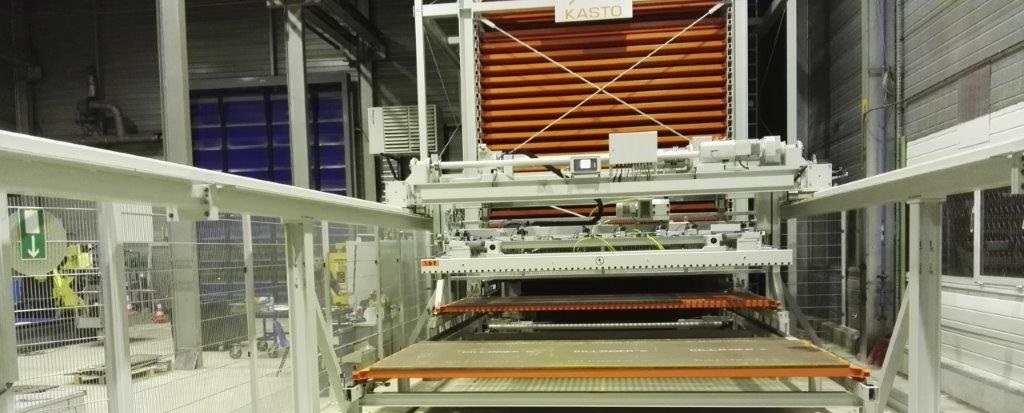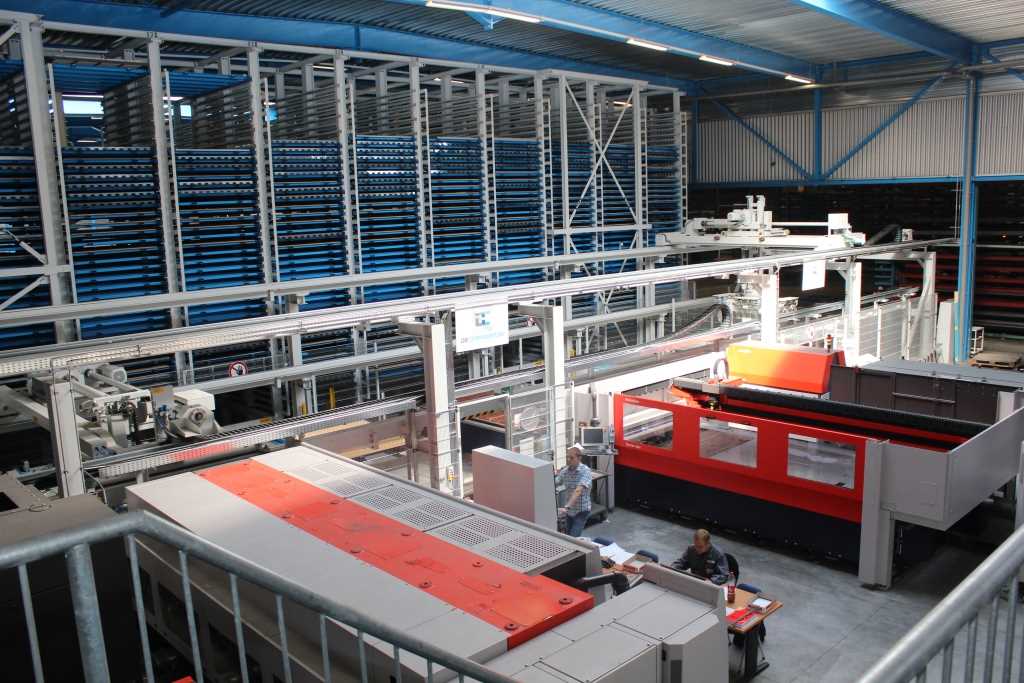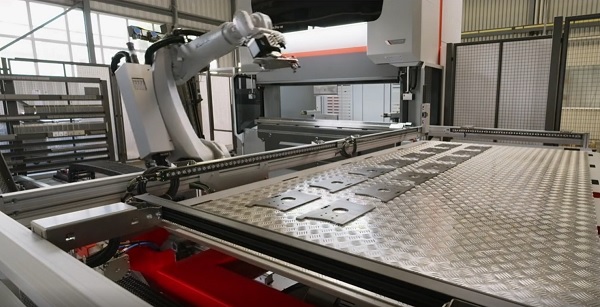The flow of raw materials and cut parts strongly impacts the productivity of laser cutting machines and factory organisation. This raises the question of storage automation, both for the supply of sheet metal and the management of machined products.Indeed, the development of high-power fibre laser sources has, in turn, significantly increased the production capacity of laser cutting machines. As such, a laser machine needs to be loaded or unloaded almost continuously, particularly when the production consists of thin or medium thickness sheets.
Production operations following the machining of sheets are also impacted by this volumetry.
Pierangelo Tartaglia - Bystronic comments that, "well-equipped and very well-organised companies can achieve a utilisation rate of 85% of their laser machine’s cutting capacity."The cutting station is often the first production station, particularly in a sheet metal factory. It is therefore a good place to start when thinking about how to structure the flow of raw material and finished or semi-finished parts.
According to Rigobert Ghomsi and Marie-Christine Koch, the first two questions to ask are:
-
Does your raw material flow enable you to use your laser machine optimally, in relation to its production capacity? In other words, is the machine sometimes waiting for sheets to produce?
-
After cutting, what is the production process like? Have you identified the difficulties and their impacts?
Article written with the help and/or illustrations of the following companies: Amada, Bystronic, Kasto, LVD, Prima Power, Salvagnini, TCI Cutting et Trumpf-
Collecting Data to Properly Size Your Automatic Storage System
Even if a storage system is only initially used for a laser machine, having a global vision of these flows can help you to identify the points of weakness and loss of productivity at each transfer or production phase. This allows to estimate, more or less accurately, the company’s overall flow. This data can help you make an informed choice in terms of storage systems and to invest in a scalable solution.
With accurate, real and predictive production data, companies will be able to determine their priorities.
Management of Raw Material and its Availability at the Cutting Station
Supplying cutting machines with sheet metal often gives rise to lots of issues, such as managing a wide range of different material grades and thicknesses, moving material from the storage space to the cutting machines, and organising offcuts for later use.
Loïc Vicaud – Trumpf notes that, “as the first production station, laser cutting often suffers from poor upstream material organisation. It is also often the first area to look at when implementing an automatic storage system.”
Copyright Kasto The analysis can therefore be based on a few simple pieces of information or data:
- Number of different material references (grade/thickness/size) and those representing 80% of production.
- The list of steps taken to remove one or more sheets and transport them to the machine: operating the forklift + moving it to the storage rack, extracting the complete pack/pallet of sheets, removing the number of sheets required, putting the pack/pallet of sheets back on the rack, recording the removal of sheets in the company’s management tool, moving and positioning the sheets on the machine, etc.
- Observation of any difficulties at each step, e.g.: separating the sheets to take the right quantity, especially thin sheets, scraps generated during handling, difficulties in finding a sheet or a scrap, safety issues during transport, etc.
- Measurement of the overall average time required to extract a sheet and load it onto the machine, in order to estimate the daily amount of time spent on supplying the cutting area.
- Estimation of laser machine down-time relating to material supply.
This data can confirm whether or not an automatic storage system is worthwhile and provide an initial idea of the size required.
Franck Ferrari – Amada explains that “today, laser machines are so productive, that most new installations are equipped with a storage tower to increase autonomy and keep up with the speed at which the machine requires raw material to be supplied.”
Storage of Cut Parts Exiting the Laser Machine
When cut parts exit a laser machine, they can be inserted into an automatic storage system in several different ways:
-
Storage of the complete cut sheet metal in a storage tower, to be sorted later.
-
Sorted beforehand by a robot or an operator, and then inserted into the system on pallets.

Copyright Kasto The main purpose of using a storage system at the output of laser cutting machines is to store parts or a production batch. The digital identification linked to the automatic storage system makes it easy to find a production.
Pierangelo Tartaglia – Bystronic insists on “the importance of creating an output organisation to optimise the use of the laser machine and others: press brake, welding, painting, etc."
The storage of semi-finished parts can also lead to questions about the overall flow of parts in the factory once the cutting operation has been completed.
-
The Flow of Parts From One Production Station to the Next
Moving parts from one station to another is time-consuming and often impacts the productivity of the production stations waiting to be supplied. Traceability is also often difficult to implement. A reflection on the flow can lead to the automation of certain supply operations for semi-finished parts. Indeed, storage systems offer many possibilities for improving flows and increasing their automation, while still enabling manual phases when necessary. The transfer of parts is usually automated with conveyers, retrieval machines, manipulator robots, etc.
Loïc Vicaud – Trumpf insists on "the importance of looking at the material flow”.
After an initial assessment, the manufacturer will therefore have a clearer idea of what can be improved and draw up:
Copyright Bystronic -
A list of parts handling operations in a typical day, noting the production station involved, the destination station, the time it takes, and any difficulties encountered.
-
An assessment of productivity losses at production stations related to the handling of parts in the factory.
-
An identification of storage and buffer stock areas in the factory, and their impact.
As discussed throughout this article, the question of storage in automatic towers or systems leads to a global reflection about the flow of raw materials and parts in the factory. This is one of the important steps to enter the world of ‘Smart Factories’ (automated, connected and productive).
Copyright – reproduction prohibited without Metal-Interface’s permission-
Metal-Interface takes great care to protect your privacy: when you submit a request or ask a question, your personal information is passed on to the supplier concerned or, if necessary, to one of its regional managers or distributors, who will be able to provide you with a direct response. Consult our Privacy Policy to find out more about how and why we process your data, and your rights in relation to this information. By continuing to browse our site, you accept our terms and conditions of use.
- Technical Report on Laser Cutting Technical article
Laser Cutting: How to Organise Your Flow With an Automatic Storage System
